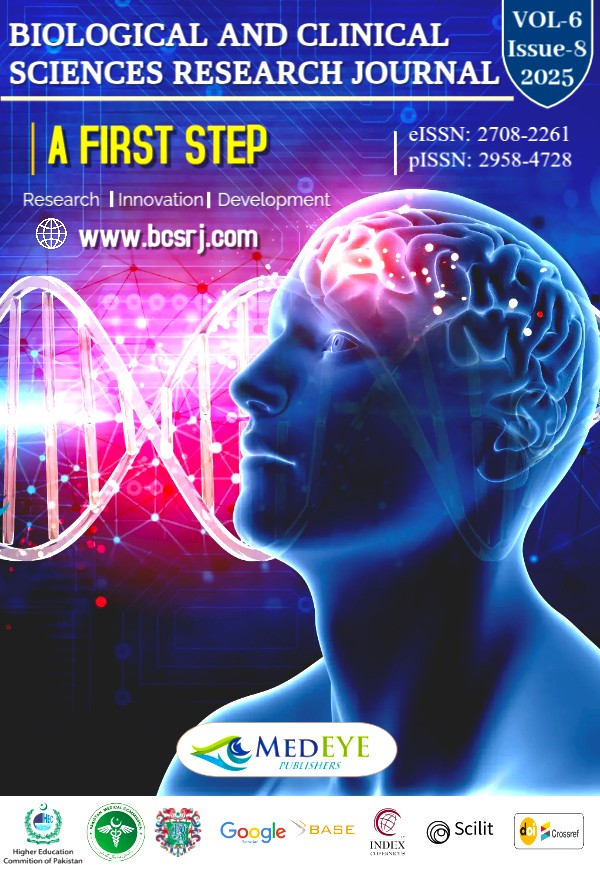Exploring the Link Between Biofilm Formation and Multidrug Resistance in Escherichia coli Isolated from Urinary Tract Infections in Sialkot, Pakistan
DOI:
https://doi.org/10.54112/bcsrj.v6i8.1932Keywords:
Urinary Tract Infection, Biofilm, Multidrug Resistance, Infection, SialkotAbstract
Escherichia coli strains are among the key contributors to urinary tract infections (UTIs) around the world, presenting a significant health challenge globally. Objectives: This cross-sectional study aims to isolate multidrug-resistant (MDR) Escherichia coli strains from UTI patients in Sialkot, Pakistan, and to investigate their biofilm-forming ability, exploring the possible association between biofilm formation and antibiotic resistance. Methods: A total of 131 E. coli isolates were isolated and identified. Their ability to form biofilms was confirmed using the tube method, and their antibiotic susceptibility patterns were evaluated using the disc diffusion method. Fisher's exact test was applied to investigate the association between biofilm production and antibiotic resistance. Results: The findings revealed that 65.6% isolates (n = 88) were biofilm producers, while 34.4% (n = 43) were non-biofilm producers. Antibiotic sensitivity testing indicated high levels of resistance among isolates to several antibiotics, notably ceftriaxone (91.6%), cefoperazone (86.3%), ciprofloxacin (85.5%), cefotaxime (82.4%), and cefixime (81.7%). A significant association was observed between biofilm formation and resistance to most antibiotics, including nitrofurantoin, amoxicillin-clavulanate, amikacin, piperacillin-tazobactam, and sulfamethoxazole-trimethoprim, among others. Conclusion: These findings suggest that E. coli isolates resistant to these certain antibiotics are more likely to form biofilms. This research highlights the critical need to explore biofilm formation, along with antibiotic susceptibility patterns of isolates, to help select appropriate antibiotics and facilitate effective treatment approaches.
Downloads
References
Zagaglia C, Ammendolia MG, Maurizi L, Nicoletti M, Longhi C. Urinary tract infections caused by uropathogenic Escherichia coli strains—new strategies for an old pathogen. Microorganisms. 2022;10(7):1425. https://doi.org/10.3390/microorganisms10071425
Alshaikh SA, El-Banna T, Sonbol F, Farghali MH. Correlation between antimicrobial resistance, biofilm formation, and virulence determinants in uropathogenic Escherichia coli from Egyptian hospital. Ann Clin Microbiol Antimicrob. 2024;23(1):20. https://doi.org/10.1186/s12941-024-00643-1
Walker MM, Roberts JA, Rogers BA, Harris PN, Sime FB. Current and emerging treatment options for multidrug resistant Escherichia coli urosepsis: a review. Antibiotics. 2022;11(12):1821. https://doi.org/10.3390/antibiotics11121821
Halaji M, Fayyazi A, Rajabnia M, Zare D, Pournajaf A, Ranjbar R. Phylogenetic group distribution of uropathogenic Escherichia coli and related antimicrobial resistance pattern: a meta-analysis and systematic review. Front Cell Infect Microbiol. 2022;12:790184. https://doi.org/10.3389/fcimb.2022.790184
Masoud SM, Abd El-Baky RM, Aly SA, Ibrahem RA. Co-existence of certain ESBLs, MBLs and plasmid mediated quinolone resistance genes among MDR E. coli isolated from different clinical specimens in Egypt. Antibiotics. 2021;10(7):835. https://doi.org/10.3390/antibiotics10070835
El-Baz R, Said HS, Abdelmegeed ES, Barwa R. Characterization of virulence determinants and phylogenetic background of multiple and extensively drug resistant Escherichia coli isolated from different clinical sources in Egypt. Appl Microbiol Biotechnol. 2022;106(3):1279–1298. https://doi.org/10.1007/s00253-021-11729-x
Ballén V, Cepas V, Ratia C, Gabasa Y, Soto SM. Clinical Escherichia coli: from biofilm formation to new antibiofilm strategies. Microorganisms. 2022;10(6):1103. https://doi.org/10.3390/microorganisms10061103
Lila ASA, Rajab AA, Abdallah MH, Rizvi SMD, Moin A, Khafagy E-S, et al. Biofilm lifestyle in recurrent urinary tract infections. Life. 2023;13(1):148. https://doi.org/10.3390/life13010148
Behzadi P, Urbán E, Gajdács M. Association between biofilm-production and antibiotic resistance in uropathogenic Escherichia coli (UPEC): an in vitro study. Diseases. 2020;8(2):17. https://doi.org/10.3390/diseases8020017
Yadav NS, Sharma S, Chaudhary DK, Panthi P, Pokhrel P, Shrestha A, et al. Bacteriological profile of neonatal sepsis and antibiotic susceptibility pattern of isolates admitted at Kanti Children’s Hospital, Kathmandu, Nepal. BMC Res Notes. 2018;11:1–6. https://doi.org/10.1186/s13104-018-3394-6
Hudzicki J. Kirby-Bauer disk diffusion susceptibility test protocol. American Society for Microbiology; 2009:1–23.
Karigoudar RM. Characterization and antibiotic susceptibility pattern of coagulase negative Staphylococci with special reference to methicillin resistance. Int J Curr Microbiol Appl Sci. 2016;5(3). https://doi.org/10.20546/ijcmas.2016.503.016
Mlugu EM, Mohamedi JA, Sangeda RZ, Mwambete KD. Prevalence of urinary tract infection and antimicrobial resistance patterns of uropathogens with biofilm forming capacity among outpatients in Morogoro, Tanzania: a cross-sectional study. BMC Infect Dis. 2023;23(1):660. https://doi.org/10.1186/s12879-023-08641-x
Rizwan M, Akhtar M, Najmi AK, Singh K. Escherichia coli and Klebsiella pneumoniae sensitivity/resistance pattern towards antimicrobial agents in primary and simple urinary tract infection patients visiting university hospital of Jamia Hamdard New Delhi. Drug Res (Stuttg). 2018;68(7):415–420. https://doi.org/10.1055/a-0576-0079
Islam MA, Islam MR, Khan R, Amin MB, Rahman M, Hossain MI, et al. Prevalence, etiology and antibiotic resistance patterns of community-acquired urinary tract infections in Dhaka, Bangladesh. PLoS One. 2022;17(9):e0274423. https://doi.org/10.1371/journal.pone.0274423
Johansen TEB, Botto H, Cek M, Grabe M, Tenke P, Wagenlehner FME, et al. Critical review of current definitions of urinary tract infections and proposal of an EAU/ESIU classification system. Int J Antimicrob Agents. 2011;38(Suppl):64–70. https://doi.org/10.1016/j.ijantimicag.2011.09.009
Tajbakhsh E, Ahmadi P, Abedpour-Dehkordi E, Arbab-Soleimani N, Khamesipour F. Biofilm formation, antimicrobial susceptibility, serogroups and virulence genes of uropathogenic E. coli isolated from clinical samples in Iran. Antimicrob Resist Infect Control. 2016;5:1–8. https://doi.org/10.1186/s13756-016-0128-6
Katongole P, Nalubega F, Florence NC, Asiimwe B, Andia I. Biofilm formation, antimicrobial susceptibility and virulence genes of uropathogenic Escherichia coli isolated from clinical isolates in Uganda. BMC Infect Dis. 2020;20:1–6. https://doi.org/10.1186/s12879-020-05186-1
Sabir S, Anjum AA, Ijaz T, Ali MA, Nawaz M. Isolation and antibiotic susceptibility of E. coli from urinary tract infections in a tertiary care hospital. Pak J Med Sci. 2014;30(2):389–392. https://doi.org/10.12669/pjms.302.4289
Karigoudar RM, Karigoudar MH, Wavare SM, Mangalgi SS. Detection of biofilm among uropathogenic Escherichia coli and its correlation with antibiotic resistance pattern. J Lab Physicians. 2019;11(1):17–22. https://doi.org/10.4103/JLP.JLP_98_18
Niranjan V, Malini A. Antimicrobial resistance pattern in Escherichia coli causing urinary tract infection among inpatients. Indian J Med Res. 2014;139(6):945–948. [No DOI assigned]
Khan MA, Rahman AU, Khan B, Al-Mijalli SH, Alswat AS, Amin A, et al. Antibiotic resistance profiling and phylogenicity of uropathogenic bacteria isolated from patients with urinary tract infections. Antibiotics. 2023;12(10):1508. https://doi.org/10.3390/antibiotics12101508
Shah MA, Kassab YW, Anwar MF, Al Dahoul HK, Menon S, Kaur HJ, et al. Prevalence and associated factors of urinary tract infections among diabetic patients. Health Sci J. 2019;13(2):1–5.
Downloads
Published
How to Cite
Issue
Section
License
Copyright (c) 2025 Kanwal Shehzadi, Rooma Adalat, Hafiz Abdul Sattar, Hira Ehsan, Saba Manzoor, Uzma Nisar, Sobia Alyas, Sadaf Ilyas

This work is licensed under a Creative Commons Attribution-NonCommercial 4.0 International License.








